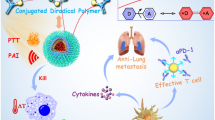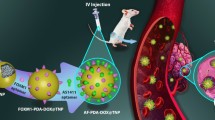Abstract
The cysteamine-modified hyaluronic acid (HA) polymer was employed to coat quantum dots (QDs) through a convenient one-step reverse micelle method, with the final QDs hydrodynamic size of around 22.6 nm. The HA coating renders the QDs with very good stability in PBS for more than 140 days and resistant to large pH range of 2–12. Besides, the HA-coated QDs also show excellent fluorescence stability in BSA-containing cell culture medium. In addition, the cell culture assay indicates no significant cytotoxicity for MD-MB-231 breast cancer cells, and its targeting ability to cancer receptor CD44 has been demonstrated on two breast cancer cell lines. The targeting mechanism was further proved by the HA competition experiment. This work has established a new approach to help solve the stability and toxicity problems of QDs, and moreover render the QDs cancer targeting property. The current results indicate that the HA polymer-coated QDs hold the potential application for both in vitro and in vivo cancer imaging researches.








Similar content being viewed by others
References
Britton HTS, Robinson RA (1931) CXCVIII.—Universal buffer solutions and the dissociation constant of veronal. J Chem Soc 1:1456–1462
Bruchez M, Moronne M, Gin P, Weiss S, Alivisatos AP (1998) Semiconductor nanocrystals as fluorescent biological labels. Science 281:2013–2016
Chan WCW, Nie S (1998) Quantum dot bioconjugates for ultrasensitive nonisotopic detection. Science 281:2016–2018
Chan WCW, Maxwell DJ, Gao X, Bailey RE, Han M, Nie S (2002) Luminescent quantum dots for multiplexed biological detection and imaging. Curr Opin Biotech 13:40–46
Chen B, Miller RJ, Dhal PK (2014) Hyaluronic acid-based drug conjugates: state-of-the-art and perspectives. J Biomed Nanotechnol 10:4–16
Cheng H-T, Chuang E-Y, Ma H, Tsai C-H, Perng C-K (2012) Fabrication of quantum dot-conjugated collagen/hyaluronic acid porous scaffold. Ann Plast Surg 69:663–667
Cheng Y, Zhao Y, Shangguan F, Ye B, Li T, Gu Z (2014) Convenient generation of quantum dot-incorporated photonic crystal beads for multiplex bioassays. J Biomed Nanotechnol 10:760–766
Cho SJ, Maysinger D, Jain M, Röder B, Hackbarth S, Winnik FM (2007) Long-term exposure to CdTe quantum dots causes functional impairments in live cells. Langmuir 23:1974–1980
Clapp AR, Goldman ER, Mattoussi H (2006) Capping of CdSe–ZnS quantum dots with DHLA and subsequent conjugation with proteins. Nat Protoc 1:1258–1266
Coradini D, Pellizzaro C, Miglierini G, Daidone MG, Perbellini A (1999) Hyaluronic acid as drug delivery for sodium butyrate: improvement of the anti-proliferative activity on a breast-cancer cell line. Int J Cancer 81:411–416
Derfus AM, Chan WC, Bhatia SN (2004) Probing the cytotoxicity of semiconductor quantum dots. Nano Lett 4:11–18
Duan HW, Kuang M, Wangi YA (2010) Quantum dots with multivalent and compact polymer coatings for efficient fluorescence resonance energy transfer and self-assembled biotagging. Chem Mat 22:4372–4378
Durgadas CV, Sreenivasan K, Sharma CP (2012) Bright blue emitting CuSe/ZnS/silica core/shell/shell quantum dots and their biocompatibility. Biomaterials 33:6420–6429
Gao X, Cui Y, Levenson RM, Chung LWK, Nie S (2004) In vivo cancer targeting and imaging with semiconductor quantum dots. Nat Biotechnol 22:969–976
Giovanelli E, Muro E, Sitbon G, Hanafi M, Pons T, Dubertret B, Lequeux N (2012) Highly enhanced affinity of multidentate versus bidentate zwitterionic ligands for long-term quantum dot bioimaging. Langmuir 28:15177–15184
Gold MH (2007) Use of hyaluronic acid fillers for the treatment of the aging face. Clin Interv Aging 2:369
Hosseinkhani H, He W-J, Chiang C-H, Hong P-D, Yu D-S, Domb A, Ou K-L (2013) Biodegradable nanoparticles for gene therapy technology. J Nanopart Res 15:1–15
Hu X, Gao X (2010) Silica-polymer dual layer-encapsulated quantum dots with remarkable stability. ACS Nano 4:6080–6086
Jana NR, Erathodiyil N, Jiang J, Ying JY (2010) Cysteine-functionalized polyaspartic acid: a polymer for coating and bioconjugation of nanoparticles and quantum dots. Langmuir 26:6503–6507
Jang YL et al (2014) Hyaluronic acid-siRNA conjugate/reducible polyethylenimine complexes for targeted siRNA delivery. J Nanosci Nanotechnol 14:7388–7394
Jiang G, Park K, Kim J, Kim KS, Hahn SK (2009) Target specific intracellular delivery of siRNA/PEI-HA complex by receptor mediated endocytosis. Mol Pharm 6:727–737
Kamat M, El-Boubbou K, Zhu DC, Lansdell T, Lu X, Li W, Huang X (2010) Hyaluronic acid immobilized magnetic nanoparticles for active targeting and imaging of macrophages. Bioconjugate Chem 21:2128–2135
Kerscher M, Bayrhammer J, Reuther T (2008) Rejuvenating influence of a stabilized hyaluronic acid-based gel of nonanimal origin on facial skin aging. Dermatol Surg 34:720–726
Kim S-W, Kim S, Tracy JB, Jasanoff A, Bawendi MG (2005) Phosphine oxide polymer for water-soluble nanoparticles. J Am Chem Soc 127:4556–4557
Kim J et al (2008) In vivo real-time bioimaging of hyaluronic acid derivatives using quantum dots. Biopolymers 89:1144–1153
Kim KS, Kim S, Beack S, Yang JA, Yun SH, Hahn SK (2012) In vivo real time confocal microscopy for target specific delivery of hyaluronic acid-quantum dot conjugates. nanomedicine: nanotechnology. Biol Med 8:1070–1073
Lee H, Mok H, Lee S, Oh YK, Park TG (2007) Target-specific intracellular delivery of siRNA using degradable hyaluronic acid nanogels. J Control Release 119:245–252
Leutwyler WK, Bürgi SL, Burgl H (1996) Semiconductor clusters, nanocrystals, and quantum dots. Science 271:933
Liu W, Choi HS, Zimmer JP, Tanaka E, Frangioni JV, Bawendi M (2007) Compact cysteine-coated CdSe (ZnCdS) quantum dots for in vivo applications. J Am Chem Soc 129:14530–14531
Liu W et al (2009) Compact biocompatible quantum dots via RAFT-mediated synthesis of imidazole-based random copolymer ligand. J Am Chem Soc 132:472–483
Liu L, Guo X, Li Y, Zhong X (2010) Bifunctional multidentate ligand modified highly stable water-soluble quantum dots. Inorg Chem 49:3768–3775
Lovrić J, Cho SJ, Winnik FM, Maysinger D (2005) Unmodified cadmium telluride quantum dots induce reactive oxygen species formation leading to multiple organelle damage and cell death. Chem Biol 12:1227–1234
Luo Y, Prestwich GD (1999) Synthesis and selective cytotoxicity of a hyaluronic acid-antitumor bioconjugate. Bioconjugate Chem 10:755–763
Medintz IL, Uyeda HT, Goldman ER, Mattoussi H (2005) Quantum dot bioconjugates for imaging, labelling and sensing. Nat Mater 4:435–446
Palui G, Na HB, Mattoussi H (2011) Poly(ethylene glycol)-based multidentate oligomers for biocompatible semiconductor and gold nanocrystals. Langmuir 28:2761–2772
Pellegrino T et al (2004) Hydrophobic nanocrystals coated with an amphiphilic polymer shell: a general route to water soluble nanocrystals. Nano Lett 4:703–707
Platt VM, Szoka FC Jr (2008) Anticancer therapeutics: targeting macromolecules and nanocarriers to hyaluronan or CD44, a hyaluronan receptor. Mol Pharm 5:474–486
Qu L, Peng X (2002) Control of photoluminescence properties of CdSe nanocrystals in growth. J Am Chem Soc 124:2049–2055
Ruan G, Agrawal A, Marcus AI, Nie S (2007) Imaging and tracking of tat peptide-conjugated quantum dots in living cells: new insights into nanoparticle uptake, intracellular transport, and vesicle shedding. J Am Chem Soc 129:14759–14766
Saravanakumar G, Deepagan V, Jayakumar R, Park JH (2014) Hyaluronic acid-based conjugates for tumor-targeted drug delivery and imaging. J Biomed Nanotechnol 10:17–31
Schroedter A, Weller H, Eritja R, Ford WE, Wessels JM (2002) Biofunctionalization of silica-coated CdTe and gold nanocrystals. Nano Lett 2:1363–1367
Shiohara A, Hoshino A, Hanaki Ki, Suzuki K, Yamamoto K (2004) On the cyto-toxicity caused by quantum dots. Microbiol Immunol 48:669–675
Smith AM, Nie S (2008) Minimizing the hydrodynamic size of quantum dots with multifunctional multidentate polymer ligands. J Am Chem Soc 130:11278–11279
Smith AM, Nie S (2011) Bright and compact alloyed quantum dots with broadly tunable near-infrared absorption and fluorescence spectra through mercury cation exchange. J Am Chem Soc 133:24
Smith AM, Duan H, Mohs AM, Nie S (2008a) Bioconjugated quantum dots for in vivo molecular and cellular imaging. Adv Drug Deliver Rev 60:1226–1240
Smith AM, Mohs AM, Nie S (2008b) Tuning the optical and electronic properties of colloidal nanocrystals by lattice strain. Nat Nanotechnol 4:56–63
Steponkiene S, Valanciunaite J, Skripka A, Rotomskis R (2014) Cellular uptake and photosensitizing properties of quantum dot-chlorin e 6 complex: in vitro study. J Biomed Nanotechnol 10:679–686
Stewart MH et al (2010) Multidentate poly(ethylene glycol) ligands provide colloidal stability to semiconductor and metallic nanocrystals in extreme conditions. J Am Chem Soc 132:9804–9813
Uskoković V, Drofenik M (2005) Synthesis of materials within reverse micelles. Surf Rev Lett 12:239–277
Wang TW, Sun JS, Wu HC, Tsuang YH, Wang WH, Lin FH (2006) The effect of gelatin-chondroitin sulfate-hyaluronic acid skin substitute on wound healing in SCID mice. Biomaterials 27:5689–5697
Wu X et al (2002) Immunofluorescent labeling of cancer marker Her2 and other cellular targets with semiconductor quantum dots. Nat Biotechnol 21:41–46
Wu YZ et al (2010) pH-Responsive quantum dots via an albumin polymer surface coating. J Am Chem Soc 132:5012–5014
Xie R, Kolb U, Li J, Basché T, Mews A (2005) Synthesis and characterization of highly luminescent CdSe-Core CdS/Zn0. 5Cd0. 5S/ZnS multishell nanocrystals. J Am Chem Soc 127:7480–7488
Xing Y et al (2007) Bioconjugated quantum dots for multiplexed and quantitative immunohistochemistry. Nat Protoc 2:1152–1165
Yadav AK, Mishra P, Agrawal GP (2008) An insight on hyaluronic acid in drug targeting and drug delivery. J Drug Target 16:91–107
Yildiz I, McCaughan B, Cruickshank SF, Callan JF, Raymo FiM (2009) Biocompatible CdSe-ZnS core-shell quantum dots coated with hydrophilic polythiols. Langmuir 25:7090–7096
Yildiz I, Deniz E, McCaughan B, Cruickshank SF, Callan JF, Raymo FiM (2010) Hydrophilic CdSe-ZnS core-shell quantum dots with reactive functional groups on their surface. Langmuir 26:11503–11511
Ying JY, Zarur A (2002) Synthesis of nanometer-sized particles by reverse micelle mediated techniques. US Patent 6,413,489
Zhang P et al (2012) Click-functionalized compact quantum dots protected by multidentate-imidazole ligands: conjugation-ready nanotags for living-virus labeling and imaging. J Am Chem Soc 134:8388–8391
Zheng H, Chen G, DeLouise LA, Lou Z (2010) Detection of the cancer marker CD146 expression in melanoma cells with semiconductor quantum dot label. J Biomed Nanotechnol 6:303–311
Acknowledgments
We acknowledge the financial support by the Wallace H. Coulter GT/Emory-PKU BME collaborative research seed grant program and the National Key Instrumentation Development Project (2011YQ030114), as well as Guangdong Innovative Research Team Program (No. 2011S090). We also thank Dr. Andrew M. Smith for kindly providing the QDs.
Author information
Authors and Affiliations
Corresponding authors
Rights and permissions
About this article
Cite this article
Wang, H., Sun, H., Wei, H. et al. Biocompatible hyaluronic acid polymer-coated quantum dots for CD44+ cancer cell-targeted imaging. J Nanopart Res 16, 2621 (2014). https://doi.org/10.1007/s11051-014-2621-x
Received:
Accepted:
Published:
DOI: https://doi.org/10.1007/s11051-014-2621-x




